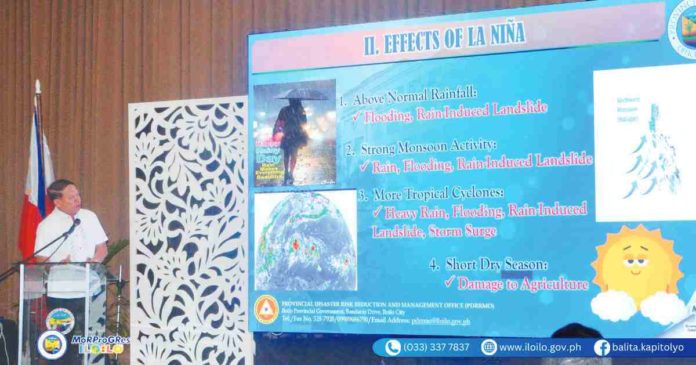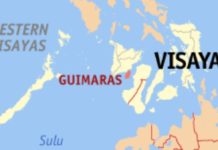
ILOILO – The provincial government is ramping up its preparations in anticipation of the La Niña season – a climate pattern characterized by unusually high volumes of precipitation – expected to start as early as June. Areas “very highly susceptible” to flooding, landslides and storm surges have been identified.
There is a 60 percent likelihood that La Niña could commence between June and August, according to forecasts by the Philippine Atmospheric, Geophysical and Astronomical Services Administration (PAGASA).
During a meeting of the Provincial Disaster Risk Reduction and Management Council (PDRRMC) on Monday, April 29, Cornelio Salinas, head of the Provincial Disaster Risk Reduction and Management Office (PDRRMO), bared the municipalities listed as “very highly susceptible” to flooding, landslides and storm surges:
* flooding – Oton (1st District); Leganes, Pavia and Zarraga (2nd District); Calinog and Pototan (3rd District); Barotac Nuevo, Dueñas and Passi City (4th District); and Balasan, Carles, Concepcion, and Estancia (5th District)
* landslides – Igbaras, Miag-ao, San Joaquin, and Tubungan (1st District); Alimodian and Leon (2nd District); Calinog, Janiuay, Lambunao, and Maasin (3rd District); San Enrique (4th District); and Ajuy, Barotac Viejo and Sara (5th District)
* storm surges – Guimbal, Miag-ao, San Joaquin, Tigbauan, and Oton (1st District); Leganes and Zarraga ( 2nd District); Anilao, Banate, Barotac Nuevo, and Dumangas (4th District); and Ajuy, Batad, Carles, Estancia, and San Dionisio (5th District)
Salinas also detailed the readiness measures, emphasizing enhancements in manpower, resources and logistics.
The province’s disaster response arsenal includes 13 PDRRMO staff, 13 Provincial Civil Defense Operation Center personnel, and 28 emergency responders ready for deployment.
Iloilo has also equipped itself with five patient transport vehicles, three multipurpose vehicles, two delivery vans, 42 rescue boats, and 10 dump trucks to ensure mobility during disasters.
Further bolstering the province’s preparedness, eight local government units are maintaining “resilience hubs” complete with responder and rescue equipment, and 16 units equipped with disaster risk reduction and management tools.
As for supplies, Salinas highlighted the stockpiling of over 7,000 pieces of canned goods, with additional orders worth P160,000, including noodles and coffee, to ensure sufficient resources are on hand.
Looking forward, Salinas outlined the need for ongoing training and skills enhancement for responders and personnel to ensure proficiency in using and maintaining disaster management equipment.
He also emphasized the importance of keeping all equipment in good working condition through regular maintenance and the use of an inventory system to monitor equipment status.
Salinas proposed improving resource utilization across municipalities by sharing equipment among nearby localities and establishing mutual aid agreements for emergency situations.
“For disaster response, we should come up with partnerships with all sectors, including our municipalities,” said Salinas.
Gov. Arthur Defensor Jr. also expressed the urgency of preparations, noting the possibility of typhoons entering the region as early as May, despite the ongoing El Niño.
“Even though El Niño is still in effect in May, we might already face typhoons, so we want to work with you as we coordinate operations and responses with our local government units, here in the province, and with our partners,” said Defensor.
He emphasized the importance of smooth communication between the provincial government and local government units to expedite the delivery of assistance and personnel to areas in need./PN





